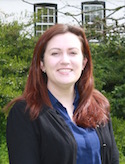Beth Singler was a Research Associate on the Human Identity in an age of Nearly-Human Machines project. She was working with Professor John Wyatt and Professor Peter Robinson to explore the social and religious implications of technological advances in AI and robotics.
Beth’s research explores popular and religious re-imaginings of science and technology. She is an experienced social and digital anthropologist of New Religious Movements, and her recently completed PhD thesis is the first in-depth ethnography of the ‘Indigo Children’ – a New Age re-conception of both children and adults using the language of evolution and spirituality. She has also published on the development and legitimation of Jediism and Scientology through social media.
Beth has completed three Theology and Religious Studies degrees at the Faculty of Divinity, Cambridge: undergraduate, masters and PhD. She has taught at the Faculty on “Understanding Contemporary Religion” and “Topics in the Study of Religion” and “Spritualism, Mesmerism and, Physical research”, as well as presenting her work to the public through the Cambridge Festival of Ideas as a “Cambridge University Rising Star”. She has also been interviewed for the BBC’s Inside Out documentary series, and by the BBC News, LBC radio, Radio 5 Live and radio 4’s Today programme. In 2017 she was one of The “Hay 30” for The Hay Literary Festival.
Twitter: @BVLSingler
Selected publications:
Monograph (under contract)
“The Indigo Children: An Evolution of Self and Spirituality in a Networked New Age” (Farnham, UK: Ashgate, forthcoming)
Refereed journal articles
“‘My Brother, the Insect’: Ethnographic Research on the Indigo Children, Their New Age Cosmologies, and Spiritual Guides”, in The Journal of the British Association for the Study of Religions, DISKUS 17.2 (2015), pp 54-67
“The Indigo Child Concept and Biomedical Conspiracy Theories” in Nova Religio: The Journal of Alternative and Emergent Religions, (2015) Vol. 19 No. 2, pp. 17-29
“’SEE MOM IT IS REAL’: The UK Census, Jediism and Social Media”, in Journal of Religion in Europe, Volume 7, Issue 2, June 2014
Book chapters
“The New Age Movement and the Definition of the Child, as expressed in the Indigo Child Concept” in Parker, S., Ridgely, S. and Strhan, A (eds.) The Bloomsbury Reader in Religion and Childhood (London: UK, Bloomsbury, forthcoming)
“No Leader, No Followers: The Internet and the End of Charisma?” in Inform’s 25thAnniversary Conference Volume (Farnham, UK: Ashgate, forthcoming)
“Internet-based New Religious Movements and Dispute Resolution” in Sandberg, R. (ed.) (2015) Religion and Legal Pluralism (Aldershot UK: Ashgate)
“New Age Movement, Possession and Exorcism in”, in Laycock, J. (ed.) (2015) Spirit Possession Around the World: Possession, Communion, and Demon Expulsion across Cultures (California, USA: ABC-CLIO)
Book reviews
Campion, N (2012) Astrology and Popular Religion in the Modern West: Prophecy, Cosmology and the New Age Movement, in Religious Studies Review, Volume 40, Issue 4, pages 195–196, December 2014
Cusack, C. (2010) Invented Religions, Imagination Fiction and Faith (Aldershot, UK: Ashgate) Reviewed in Fieldwork in Religion, Vol 5, No 2 (2010)
Collins-Mayo, S., and P. Dandelion (eds) (2010) Religion and Youth (Aldershot UK: Ashgate). Reviewed in Fieldwork in Religion, Vol 8, No 1 (2013)
Bailey, M., and G. Reddon (eds) (2010) Mediating Faiths: Religion and Socio-Cultural Change in the 21st Century (Aldershot, UK: Ashgate). Reviewed inFieldwork in Religion, Vol 8, No 1 (2013)




